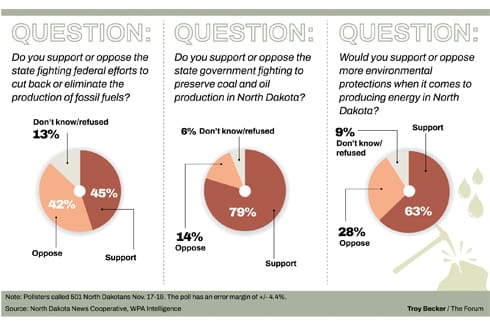Carbon capture plans may not be worth climate, financial rsks
Hopes remain the technology can be demonstrated to work as advertised

CENTER, N.D. – As the State of North Dakota trumpets Project Tundra, experts outside of the state raise questions about capturing carbon dioxide emissions from two units at coal-fired Milton R. Young Power Plant near Center.
The only real certainty is that the initiative will be expensive and will result in unabated carbon emissions at least through 2028, if not longer, under the projected construction timeline. Costs of producing energy will also rise due to the technology needed to capture the emissions and pump them deep underground.
For some, the expenditures don’t make sense financially and they don’t make sense when it comes to reducing carbon emissions.
“The Milton Young plant is 50 years old, for God’s sakes, and coal plants don’t tend to last much longer than that,” said Dennis Wamsted, a Boston-based energy analyst at the Institute for Energy Economics and Financial Analysis.
“Basically, you’re putting carbon capture on a facility that was scheduled to shut down in the very near future,” Wamsted said. “That makes no sense to us. There are many viable options to replace that power. They’re here now, they’re clean, and they’re cheap and reliable.”
If the project is completed and gets up and running, 45Q tax credit subsidies under the Inflation Reduction Act will provide up to $85 per metric ton of CO2 that is permanently stored directly beneath the facility.
The tax subsidy program lasts for a total of 12 years, and after that the power plant would need to cover the sequestration costs itself or potentially stop capturing those emissions. If 45Q tax credits are extended, subsidies could continue to keep the facility operating.
Capturing a projected 4 million tons of CO2 per year at $85 per ton for 12 years would amount to a subsidy of $4.08 billion over that period.
North Dakota’s Clean Sustainable Energy Authority already approved a $100 million loan from state funds for up front capital costs for the project and is considering another $150 million on top.
The participants in the project -- Minnkota Power Cooperative, TC Energy, Mitsubishi Heavy Industries and Kiewit -- have also applied for a separate $350 million grant from the U.S. Department of Energy.
Up front capital costs needed to complete the project and get it running are estimated at $1.4 billion.
All those costs combined may end up being greater than it would be to close the facility and transition to other forms of energy, said Jeremy Fisher, a senior advisor with the Sierra Club's Environmental Law Program based in San Francisco.
“And then at the back end of that 12 years, that’s it . . . you’re not going to keep operating that carbon capture and sequestration plant,” he said.
“It costs both a lot to build in the first place, but then when it’s operating it requires an extraordinary amount of money to keep it running,” Fisher said. “It only operates as long as the subsidy is in play, which is fundamentally different than about any other technology we subsidize or don’t subsidize.”
Ben Faldhammer, a spokesman for Minnkota Power Cooperative which operates Milton Young, said capital costs for the facility would have already been recouped, but added that Congress would likely have to extend 45Q for further sequestration to make sense.
“A decision will need to be made on whether it is advantageous to continue paying for the operating cost of the capture facility,” Faldhammer said. “If the Young station remains a reliable and economic resource, we may continue operating the capture facility to comply with regulation, limit exposure to potential carbon taxes or meet other decarbonization goals.”
Faldhammer said the costs of Project Tundra are expected to have minimal or no impact on Minnkota rate payers.
“After the 12-year tax credit period, we have no obligation to continue to incur operating cost if the capture system is not beneficial to our operations and our membership we serve,” he said.
The price of demonstration
For Emily Grubert, an energy systems expert and professor at the University of Notre Dame in Indiana who has tracked the Project Tundra imitative, the effort appears to be more aimed at saving the lignite coal mining industry in North Dakota than saving this particular plant. Another prospective project that could be implemented at the Coal Creek power plant is in the study phase.
Proponents of the capture facility argue that North Dakota could be a leader in testing and demonstrating that the technology works and could be applied to other coal plants elsewhere. Grubert doesn’t necessarily buy that.
“Having demonstration on a full plant is actually meaningful, having demonstration that’s coupled with dedicated storage is actually meaningful,” she said. “Where I get off the train is how applicable the lessons will be. It’s a mine-mouth lignite plant that’s 50 years old. Most of the other plants people are looking at don’t look like this one, and so how much you learn that you can apply somewhere else I think is limited.”
Grubert doesn’t see much potential financial impact to North Dakotan’s directly, other than the general federal tax implications. That $4 billion in federal tax subsidies isn’t chump change.
Questions also remain on what will be learned from the project and what the overall societal benefit is from the project, she said, especially considering these huge taxpayer dollar investments.
“I struggle to see what the benefit of this is beyond preserving the mining in the area, and you know, that’s going to end at some point,” she said.
Harry Kennard, a senior research associate at the Center on Global Energy Policy at Columbia University in New York City, takes the view that initiatives like Project Tundra need to be tried, particularly considering North Dakota has some of the best underground storage space for CO2 in the world.
“The scale of the problem we have with CO2 emissions is that we’ve sort of got to try everything,” Kennard said. “The transition will be messy. This project, if it is built and demonstrates that it works, then you can do better things with it than burning coal.”
Kennard gave the example of the potential for plants like this to use a biomass fuel stock that could produce negative emissions, with that stock being grown to remove CO2 from the atmosphere.
“If this project prolongs the life of this particular coal power plant another 10 or 20 years, that’s maybe not as good as if it was replaced by renewables, but I don’t necessarily see it as being an either or proposition,” Kennard said.
Kennard said that in addition to the facility, a deeper rollout of wind, solar and other renewable power is also needed because of the scale of the global CO2 issue.
U.S. Sen. John Hoeven, a supporter of the project, said it will help lead the way forward in developing new technology to produce more energy for the country as a whole.
“The result is that North Dakota can keep its coal-fired electric industry operating, providing needed baseload power for our country,” Hoeven said. “Also by leading the way forward, we will help the energy industry, as well as other industries, in this country and others to develop and adopt these decarbonization technologies as well.”
Emission capture rates uncertain
With a projected capture rate of 90 percent, the Milton Young plant is targeted to emit at least 10 percent of its carbon emissions per year even after the carbon capture technology is built.
No other large scale carbon capture project on a coal fired power plant worldwide has met those efficiency rates, meaning the real rate of emissions would likely be much higher if it doesn’t work as planned.
The only comparable unit -- Boundary Dam CCS in southern Saskatchewan -- has started to capture less carbon dioxide over time, with 43 percent fewer metric tons of carbon dioxide captured in 2021 than the year before.
Milton Young’s Unit 1 is now 53 years old. Unit 2, owned by Square Butte Power Cooperative, but operated by Minnkota, is 46 years old.
“We are working with some of the world’s leading and largest manufacturers to ensure the performance of the capture system,” Fladhammer said. “We have a high level of confidence in the CO2 capture technology and the ability to successfully implement it at the Young station.”
According to Fladhammer, Project Tundra is designed to process all the flue gas from the 445 megawatt Unit 2, and a portion flue gas from Unit 1’s 250 megawatts of production, with the potential to capture all of Unit 1’s gases if Unit 2 is offline for maintenance.
“It’s very unlikely to work at 90 percent every day for over 20 years,” Wamsted said. “We don’t see that happening and we’ve done an awful lot of research. It hasn’t happened anywhere.”
Paul Jensen, interim director of Citizens Local Energy Action Network [CLEAN] out of Fargo, said his organization sees the project as one “trying to revive a dead corpse,” he said.
“The efficiency of these investments are not exactly satisfactory,” Jensen said.
The North Dakota News Cooperative is a nonprofit news organization providing reliable and independent reporting on issues and events that impact the lives of North Dakotans. The organization increases the public’s access to quality journalism and advances news literacy across the state. For more information about NDNC or to make a charitable contribution, please visit newscoopnd.org. Send comments, suggestions or tips to michael@newscoopnd.org. Follow us on Twitter: https://twitter.com/NDNewsCoop.



